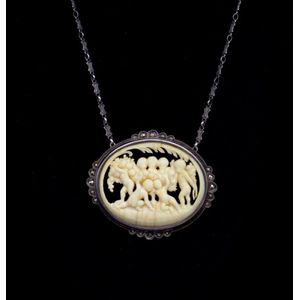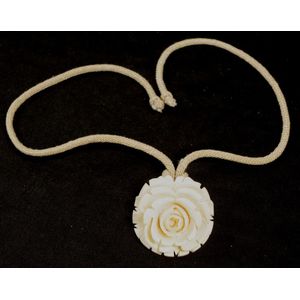
Ivory Jewelry Collection: Bangle, Pendant, Brooch, Rose, Seal, Brush
Ivory bangle, ivory and gold pendant, carved ivory floral brooch, carved ivory rose, turned ivory seal, and a carved ivory brush, 19th/20th century, (6 items), the seal 10 cm long

Antique Carved Ivory Cruciform Pendant with Grapevine Detail
An antique carved ivory cruciform pendant, finely carved grapevine detail, size 10.5 x 5.5 cm, wt. 33.67g.

Whimsical Ivory and Diamond Pendant on White Gold Chain
A Cute ivory and diamond pendant, an ivory sphere with whimsical carved face which is festooned with small white diamonds. Diameter: 18.4 mm. Fitted to a fine 9ct white gold 40 cm long chain.

Japanese Ivory Lion Pendant
Japanese antique ivory pendant, hand carved ivory pendant depicting lion in relief

Jadeite Ring, Ivory Beads, Carnelian Brooch: Exquisite Jewelry Trio
Three jewellery items, consisting of a carved olive green jadeite type nephrite ring, a strand of ivory round beads and a carnelian oval brooch/ pendant.(3)

Carved Ivory Apple Pendant: Garden Scene Inside
Antique carved ivory pendant, shape of an apple with carved interior depicting garden scene

Carved Ivory Rose Pendant on Leather Cord with Silver Fittings
A vintage carved ivory rose pendant, on leather cord with silver fittings.

Serpent Fist Ivory Pendant
Victorian ivory pendant, carved ivory pendant in the form of a clutching fist with entwined serpent

Mid 20th Century Ivory Jewelry Set
Mid 20th century ivory group includes: carved bangle W: 10 mm, x Dia: 8.5 cm, two ivory necklace L: 44 cm & 90 cm, also with a pendant. This item cannot be exported

Carved Ivory Pendant with Silver Chain and Marcasite
Antique carved ivory and silver pendant and chain also set with marcasite, marked sterling. Showing a carved panel of putti with garlands, some crazing splits, length 62 cm, panel size 40 x 45 mm, weight 25 grams. This item cannot be exported

Carved Ivory Beaded Necklace with Drop Pendant
Mid century carved ivory beaded necklace length 56 cm plus drop pendant, bead size 3.8-13.6 mm

Carved Ivory Pendant with Rose Gold Jump Ring
Early 20th century carved Ivory drop pendant size 19 x 12 mm., with an untested rose gold jump ring

Carved Ivory Necklace Set with Faux Ivory Bangle
Three carved ivory beaded necklace C.1950s includes an oval and roundel beaded piece without a clasp 84 cm, and elephant figural beaded and pendant strand 44 cm, an another carved piece40 cm, Also includes a faux ivory bangle. All measurements are approx.…

Moon Headdress Pendant with Peridot and Garnet
A Shano Jewelry man in the moon ivory and stone set pendant necklace; carved mammoth ivory face with headdress of pear cut peridots and garnets, to mother of pearl torso applied with a round cut garnet size 10 x 4.2 cm, on 3 mm wide foxtail link chain to…

Carved Ivory Rose Pendant, 1950s
Mid century carved ivory rose pendant Circa 1950s, Size 40 x 40 mm.

3 Jewelry Pieces: Ring, Pendant, Elephant Charm
A gold ring and two stone set pendants, 9ct ring set with a solitaire zirconia, size N, wt. 2.16g, a 7ct pendant set with a single cut diamond, length 22 mm, wt. 1.09g, and a carved ivory elephant with gilt bale, width 19 mm.

Mixed Vintage Brooch and Pendant Collection
Brooch and pendant group includes Victorian jet, early 20th century carved Edelweiss ivory brooch and green Bakelite elephant brooch, as well as a carved flower brooch.

Carved Ivory Rose Pendant Necklace
Early 20th century carved ivory necklace and pendant, necklace length 38 cm, carved rose pendant width 36 mm

Antique Jewelry Set: Amber, Ivory, Jet, and Locket
A vintage amber crystal necklace, an antique carved ivory necklace and pendant, a jet star brooch and an antique mourning locket on chain, (4 items), 19th and early 20th century,

Carved Ivory Rose Pendant - Mid Century Beauty
Mid century carved ivory rose flower pendant approx width 28 mm.

Carved Ivory Elephant Pendant from Early 20th Century
Early 20th century carved ivory elephant pendant

Bone and Ivory Pendants from Mike Higgs Estate
A carved bone lizard pendant and a faux ivory rei puta pendant. Provenance: Mike Higgs Estate Collection.

Ivory Bead Necklace with Rose Pendant and Brooch
A vintage ivory bead necklace and pendant a single strand of 107 round graduating beads with an ivory rose pendant suspended from the base, (clasp broken); together with a matching carved ivory rose brooch.

Graduated Ivory Bead Necklace with Carved Pendant
A vintage ivory bead necklace, a single strand of ninety-eight graduating beads 4.3 cm - 14.4 cm, a carved ivory pendant suspended from the base, ivory screw clasp.

Chrysanthemum Carved Ivory Necklace with Detachable Pendant
Carved ivory beaded necklace and pendant C.1950s the pendant is carved with chrysanthemum decoration and unscrew from necklace. Approx bead size 5 mm - 11.5 mm, necklace length 80 cm

Gold and Ivory Elephant Pendant Necklace with Gemstones
A vintage gold and ivory pendant necklace, a carved ivory elephant with ruby eye and 14ct gold highlights and bale set with a sapphire and emerald on an 18ct gold filed curb link chain, length 59 cm, wt. 3.95g (chain only).

Victorian Ivory Cameo Pendant with Rose Gold Detail
A Victorian carved ivory cameo pendant with rose gold detail

Antique Ivory Lady Profile Pendant
An antique ivory pendant, oval shaped, carved into a high relief lady's profile, on rose gold and brass bale. Length 55 mm.

Samurai Journey Ivory Pendant on Silver Chain
An ivory carved pendant, depicting 'The Journey of the Samourai', on silver bale and chain.

Rose Ivory Necklace
An ivory carved necklace, well carved rose pendant on ivory polished beaded necklace. Diameter 6 cm.

Carved Ivory Rose Pendant with Bail
A vintage carved ivory pendant, in the form of a large flowering rose, with ivory suspension bail.

Vintage Ivory Flower Pendant on Bead Necklace
A large vintage carved ivory flower head pendant on an ivory bead necklace, the circular pendant in deep relief, the necklace of uniform beads in screw clasp fitting. Pendant dia.5.8 cm.

Ivory Elephant Pendant with Gold Mounts and Ruby Eye
Antique carved ivory elephant figural pendant with marked 14k gold pierced work mounts, chain and a mounted marquise cut ruby to the eye

Marine Ivory Pendant by Owen Mapp
Owen Mapp, marine ivory carved pendant, incised initials, 8 cm length

Silver and Ivory Pine Cone Pendant
Tony White, sterling silver and ivory pendant, featuring a carved ivory pine cone with textured silver cap and bale, upon an elastic cord, stamped 'White Stg Sil, 41.85 grams

Antique Ivory Pendant, Family Heirloom
Vintage large carved ivory pendant, family piece since early-mid 1900s.

Oriental Ivory Carved Pendant, c. 1900
Vintage oriental carved ivory pendant, size: 11 cm length, c1900

Ivory Rose Pendant with 18ct Gold Chain
Carved ivory pendant and 18ct gold chain, carved in the form of a rose, set with 18ct gold chain

Floral Ivory Necklace on Gilded Chain
An ivory necklace, carved with floral design, on a gilded sterling silver chain. Length pendant 5.5 cm. Weight chain 1.8g.

Gilt Ivory Flower Pendant in Engraved Frame
A gilt carved ivory pendant, carved ivory with flowers mounted in a gilt frame with engraved edge, Wt 2.6grams

Grecian Maiden Ivory Pendant
Carved ivory pendant, depicting Grecian maiden picking flowers by rock, singed on reverse MM, length including bale 75 mm.

Ivory Elephant Pendant with Rose Gold Overlay
Carved ivory elephant pendant, set with 14ct rose gold overlay stamped '585 14K', missing one foot decoration, approx. Weight 16.8 grams

Ivory Rose Pendant on Silver Chain
A carved ivory pendant, egg shape with rose designs, on silver chain. Length 2.8 cm (no clasp).

Dragon Carved Ivory and Horn Pendants
Ivory and horn pendants, pair of black horns set in silver and ivory cylindrical pendant carved with dragon, both 6 cm.

Intricate Musician Scene Ivory Pendant
Antique ivory pendant intricately carved with musician scene, 9 cm long approx.

Oriental Ivory Triangle Pendant
Carved ivory triangle form pendant of Oriental design, approx 5 cm long

Ivory Rose Pendant and Bangle Set
A quality ivory rose pendant on beads and bangle, the pendant caved from a single piece of ivory, designed as an unfurled flower of stylised design, fitted with bail and suspended from a strand of round, polished ivory beads fitted with barrel clasp,…

Carved Ivory Owl Pendant with Gold Bail and Blue Eyes
A vintage carved ivory pendant styled as an owl with blue stone set eyes suspended from an 18ct yellow gold bail

Tranquil Garden Ivory Pendant
A carved ivory pendant. A carved ivory pendant in a pear / heart shape depicting a tranquil garden scene with temples and figures

Ruby Elephant Pendant in 14ct Gold Mounting
A ruby set elephant pendant, 14ct yellow gold mounted, crafted from a carved piece of ivory in a stylised form of an elephant, detailed to eye and saddle with small pink rubies claw set, gold detailed to tusk, feet and tail with gold, fitted with bail

Ivory Figures and Objects from Mary Lipshut Estate
Two carved ivory figures depicting a fisherman and a lady each with a gold mount together with a pierced and carved landscape in oval frame and an ivory tiger's tooth shaped pendant, a carved ivory four section inro (5) Provenance: the Estate of Mary…

Monkey Year Ivory Pendant with Poetic Inscription
An inscribed ivory pendant, of flat rectangular form, one side carved with a dated poetic inscription referring to the 10th year of the monkey, the ivory of caramel tones, 6.5 cm long

Carved Ivory Crocodile Pendant with Brass Mount
19th century carved ivory crocodile pendant, with ornate brass mount

Upward-Trunk Elephant Ivory Pendant
A carved ivory elephant pendant. The elephant is depicted with his truck upwards and measures 3.5 x 1.5 cm

French Ivory Cherub Pendant, c. 1870s
Dieppe ivory pendant: beautifully carved cherub amongst flowers and foliage, French c1870s. VG condition

Carved Ivory Dragon Pendant
A carved ivory dragon pendant. One kite shaped panel pendant with outer scalloped profile, carved from a single piece with a dragon motif, pierced lattice styled ground with a fixed bail, engine turning visible. Length 6.5 cm

Chrysanthemum Carved Ivory Pendant with Bead Toggle
Finely carved ivory pendant oval panel carved with chrysanthemum on braid with carve bead toggle and barrel clasp

Ivory Owl Pendant with Gold Spectacles and Onyx Eyes
A carved ivory owl pendant, having onyx eyes and 14ct yellow gold spectacles with a trace chain running down to the feet










 Loading more...
Loading more...